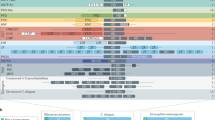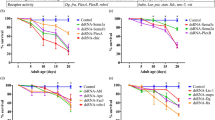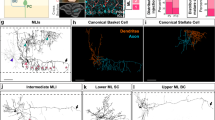Abstract
In the developing nervous system, migrating cells and axons are guided to their targets by cues in the extracellular environment. The netrins are a family of phylogenetically conserved guidance cues that can function as diffusible attractants and repellents for different classes of cells and axons1–10. In vertebrates, insects and nematodes, members of the DCC subfamily of the immunoglobulin superfamily have been implicated as receptors that are involved in migration towards netrin sources6,11–13,15. The mechanisms that direct migration away from netrin sources (presumed repulsions) are less well understood. In Caenorhabditis elegans, the transmembrane protein UNC-5 (ref. 14) has been implicated in these responses, as loss of unc-5 function causes migration defects16,17 and ectopic expression of unc-5 in some neurons can redirect their axons away from a netrin source18. Whether UNC-5 is a netrin receptor or simply an accessory to such a receptor has not, however, been defined. We now report the identification of two vertebrate homologues of UNC-5 which, with UNC-5 and the product of the mouse rostral cerebellar malformation gene (rcm)19, define a new subfamily of the immunoglobulin superfamily, and whose messenger RNAs show prominent expression in various classes of differentiating neurons. We provide evidence that these two UNC-5 homologues, as well as the rcm gene product, are netrin-binding proteins, supporting the hypothesis that UNC-5 and its relatives are netrin receptors.
This is a preview of subscription content, access via your institution
Access options
Subscribe to this journal
Receive 51 print issues and online access
$199.00 per year
only $3.90 per issue
Buy this article
- Purchase on Springer Link
- Instant access to full article PDF
Prices may be subject to local taxes which are calculated during checkout
Similar content being viewed by others
References
Ishii, N., Wadsworth, W. G., Stern, B. D., Culotti, J. G. & Hedgecock, E. M. UNC-6, a laminin related protein, guides cells and pioneer axon migrations in C. elegans. Neuron 9, 873–881 (1992).
Serafini, T. et al. The netrins define a family of axon outgrowth-promoting proteins homologous to C. elegans UNC-6. Cell 78, 409–424 (1994).
Kennedy, T. E., Serafini, T., de la Torre, J. R. & Tessier-Lavigne, M. Netrins are diffusible chemotropic factors for commissural axons in the embryonic spinal cord. Cell 78, 425–435 (1994).
Colamarino, S. A. & Tessier-Lavigne, M. The axonal chemoattractant netrin-1 is also a chemorepellent for trochlear motor axons. Cell 81, 621–629 (1995).
Shirasaki, R., Tamada, A., Katsumata, R. & Murakami, F. Guidance of cerebellofugal axons in the rat embryo: directed growth toward the floor plate and subsequent elongation along the longitudinal axis. Neuron 14, 961–972 (1995).
Wadsworth, W. G., Bhatt, H. & Hedgecock, E. M. Neuroglia and pioneer neurons express UNC-6 to provide global and local netrin cues for guiding migrations in C. elegans. Neuron 16, 35–46 (1996).
Mitchell, K. J. et al. Genetic analysis of Netrin genes in Drosophila: Netrins guide CNS commissural axons and peripheral motor axons. Neuron 17, 203–215 (1996).
Harris, R., Sabatelli, L. M. & Seeger, M. A. Guidance cues at the Drosophila CNS midline: identification and characterization of two Drosophila Netrin/UNC-6 homologs. Neuron 17, 217–228 (1996).
Serafini, T. et al. Netrin-1 is required for commissural axon guidance in the developing vertebrate nervous system. Cell 87, 1001–1014 (1996).
Shirasaki, R., Mirzayan, C., Tessier-Lavigne, M. & Murakami, F. Guidance of circumferentially growing axons by netrin-dependent and -independent floor plate chemotropism in the vertebrate brain. Neuron 17, 1079–1088 (1996).
Chan, S. S.-Y. et al. UNC-40, a C. elegans homolog of DCC (Deleted in Colorectal Cancer), is required in motile cells responding to UNC-6 netrin cues. Cell 87, 187–195 (1996).
Kolodziej, P. A. et al. frazzled encodes a Drosophila member of the DCC immunoglobulin subfamily and is required for CNS and motor axon guidance. Cell 87, 197–204 (1996).
Keino-Masu, K. et al. Deleted in Colorectal Cancer (DCC) encodes a netrin receptor. Cell 87, 175–185 (1996).
Leung-Hagesteijn, C. et al. UNC-5, a transmembrane protein with immunoglobulin and thrombospondin type 1 domains, guides cell and pioneer axon migrations in C. elegans. Cell 71, 289–299 (1992).
Fazeli, A. et al. Phenotype of mice lacking functional Deleted in Colorectal Cancer (DCC) gene. Nature 386, 796–804 (1997).
Hedgecock, E. M., Culotti, J. G. & Hall, D. H. The unc-5, unc-6 and unc-40 genes guide circumferential migrations of pioneer axons and mesodermal cells on the epidermis in C. elegans. Neuron 2, 61–85 (1990).
Mclntire, S. L., Garriga, G., White, J., Jacobson, D. & Horvitz, H. R. Genes necessary for directed axonal elongation or fasciculation in C. elegans. Neuron 8, 307–322 (1992).
Hamelin, M., Zhou, Y., Su, M. W., Scott, I. M. & Culotti, J. G. Expression of the UNC-5 guidance receptor in the touch neurons of C. elegans steers their axons dorsally. Nature 364, 327–330 (1993).
Ackerman, S.L. et al. The mouse rostral cerebellar malformation gene encodes an UNC-5 like protein. Nature 386, 838–842 (1997).
Willott, E. et al. The tight junction protein ZO-1 is homologous to the Drosophila discs-large tumor suppressor protein of septate junctions. Proc. Natl Acad. Sci. USA 90, 7834–7838 (1993).
Itoh, M. et al. The 220-kD protein colocalizing with cadherins in non-epithelial cells is identical to ZO-1, a tight junction-associated protein in epithelial cells: cDNA cloning and immunoelectron microscopy. J. Cell Biol. 121, 491–502 (1993).
Sheng. M. PDZs and receptor/channel clustering: rounding up the latest suspects. Neuron 17, 575–578 (1996).
Altman, J. & Bayer, S. A. The development of the rat spinal cord. Adv. Anat. Embryol. Cell Biol. 85, 1–166 (1984).
Ramón y Cajal, S. Histologie du Systéme Nerveux de l'Homme at des Vertébrés Vol. 2 (Maloine, Paris, 1911).
Rakic, P. Neuron–glia relationship during granule cell migration in developing cerebellar cortex. A Golgi and electron microscopic study in Macacua rhesus. J. Comp. Neurol 141, 283–312 (1971).
Klar, A., Baldassare, M. & Jessell T. M. F-spondin: a gene expressed at high levels in the floor plate encodes a secreted protein that promotes neural cell adhesion and neurite extension. Cell 69, 95–110 (1992).
Messersmith, E. K. et al. Semaphorin III can function as a selective chemorepellent to pattern sensory projections in the spinal cord. Neuron 14, 949–959 (1995).
Luo, Y., Raible, D. & Raper, J. A. Collapsin: a protein in brain that induces the collapse and paralysis of ncuronal growth cones. Cell 75, 217–227 (1993).
Guthrie, S. & Pini, A. Chemorepulsion of developing motor axons by the floor plate. Neuron 14, 1117–1130 (1995).
Varela-Echavarria, A., Tucker, A., Puschel, A. & Guthrie, S. Motor axon subpopulations respond differentially to the chemorepellents netrin-1 and semaphorin D. Neuron 18, 193–207 (1997).
Livesey. F.J. & Hunt, S. P. Netrin and netrin receptor expression in the embryonic mammalian nervous system suggests role in retinal, striatal, nigral and cerebellar development. Mol. Cell. Neurosci. (in the press). UPDATE?
Evan, G. I., Lewis, G. K., Ramsay, G. & Bishop, J. M. Isolation of monoclonal antibodies specific for human c-myc proto-oncogene product. Mol. Cell. Biol. 5, 3610–3616 (1985).
Author information
Authors and Affiliations
Rights and permissions
About this article
Cite this article
Leonardo, E., Hinck, L., Masu, M. et al. Vertebrate homologues of C. elegans UNC-5 are candidate netrin receptors. Nature 386, 833–838 (1997). https://doi.org/10.1038/386833a0
Received:
Accepted:
Issue Date:
DOI: https://doi.org/10.1038/386833a0
This article is cited by
-
The dynamic nature of netrin-1 and the structural basis for glycosaminoglycan fragment-induced filament formation
Nature Communications (2023)
-
Netrin-1 blockade inhibits tumor associated Myeloid-derived suppressor cells, cancer stemness and alleviates resistance to chemotherapy and immune checkpoint inhibitor
Cell Death & Differentiation (2023)
-
Uncoordinated protein coordinates cell migration
Nature (2022)
-
Endothelial Unc5B controls blood-brain barrier integrity
Nature Communications (2022)
-
Roles and Mechanisms of Axon-Guidance Molecules in Alzheimer’s Disease
Molecular Neurobiology (2021)
Comments
By submitting a comment you agree to abide by our Terms and Community Guidelines. If you find something abusive or that does not comply with our terms or guidelines please flag it as inappropriate.



